The Cambridge History of Japan, Vol. 1: Ancient Japan
Подождите немного. Документ загружается.

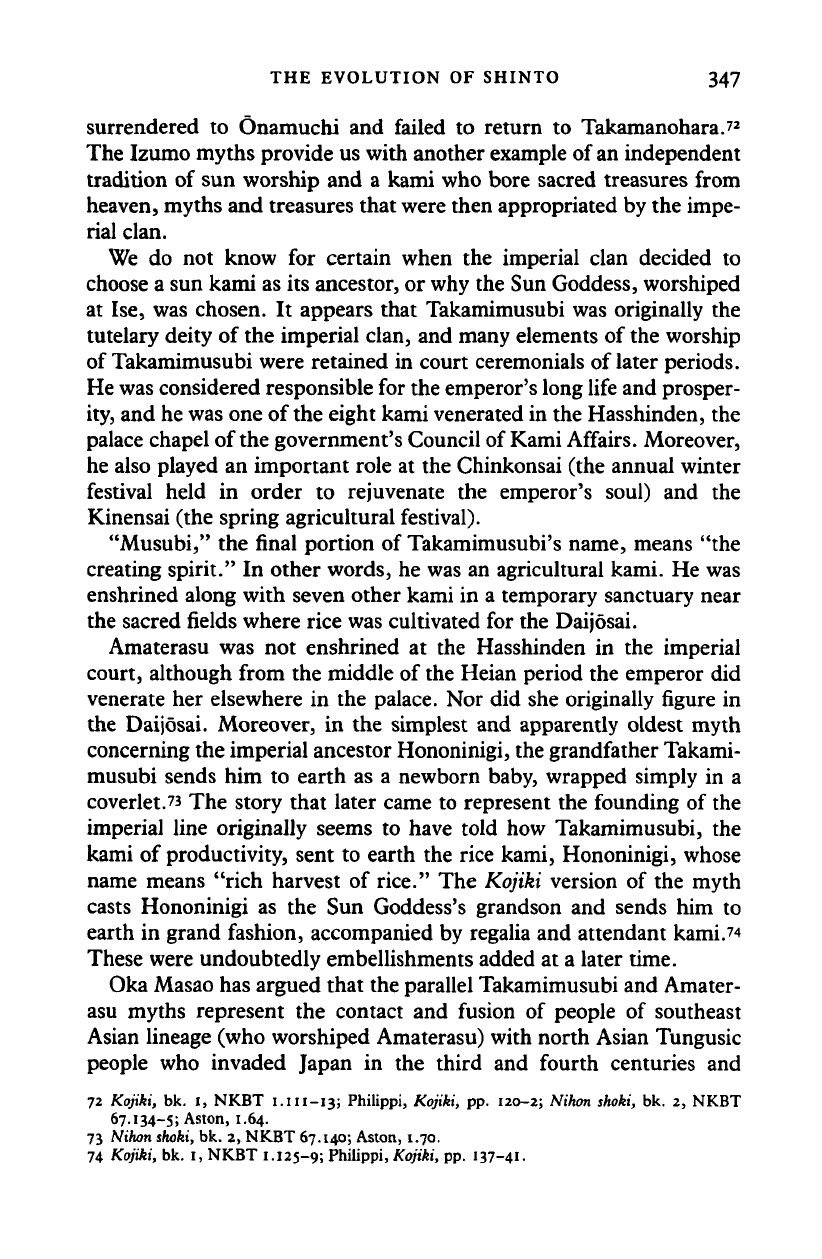
THE EVOLUTION OF SHINTO 347
surrendered to Onamuchi and failed to return to Takamanohara.
72
The Izumo myths provide us with another example of
an
independent
tradition of sun worship and a kami who bore sacred treasures from
heaven, myths and treasures that were then appropriated by the impe-
rial clan.
We do not know for certain when the imperial clan decided to
choose a sun kami as its ancestor, or why the Sun Goddess, worshiped
at Ise, was chosen. It appears that Takamimusubi was originally the
tutelary deity of the imperial clan, and many elements of the worship
of Takamimusubi were retained in court ceremonials of later periods.
He was considered responsible for the emperor's long life and prosper-
ity, and he was one of the eight kami venerated in the Hasshinden, the
palace chapel of the government's Council of Kami Affairs. Moreover,
he also played an important role at the Chinkonsai (the annual winter
festival held in order to rejuvenate the emperor's soul) and the
Kinensai (the spring agricultural festival).
"Musubi," the final portion of Takamimusubi's name, means "the
creating spirit." In other words, he was an agricultural kami. He was
enshrined along with seven other kami in a temporary sanctuary near
the sacred fields where rice was cultivated for the Daijosai.
Amaterasu was not enshrined at the Hasshinden in the imperial
court, although from the middle of the Heian period the emperor did
venerate her elsewhere in the palace. Nor did she originally figure in
the Daijosai. Moreover, in the simplest and apparently oldest myth
concerning the imperial ancestor Hononinigi, the grandfather Takami-
musubi sends him to earth as a newborn baby, wrapped simply in a
coverlet.
73
The story that later came to represent the founding of the
imperial line originally seems to have told how Takamimusubi, the
kami of productivity, sent to earth the rice kami, Hononinigi, whose
name means "rich harvest of rice." The Kojiki version of the myth
casts Hononinigi as the Sun Goddess's grandson and sends him to
earth in grand fashion, accompanied by regalia and attendant kami.™
These were undoubtedly embellishments added at a later time.
Oka Masao has argued that the parallel Takamimusubi and Amater-
asu myths represent the contact and fusion of people of southeast
Asian lineage (who worshiped Amaterasu) with north Asian Tungusic
people who invaded Japan in the third and fourth centuries and
72 Kojiki, bk. I, NKBT i.m-13; Philippi, Kojiki, pp. 120-2; Nihon shoki, bk. 2, NKBT
67.134-5; Aston, 1.64.
73 Nihon shoki, bk. 2, NKBT 67.140; Aston, 1.70.
74 Kojiki, bk. 1, NKBT 1.125-9; Philippi, Kojiki, pp. 137-41.
Cambridge Histories Online © Cambridge University Press, 2008
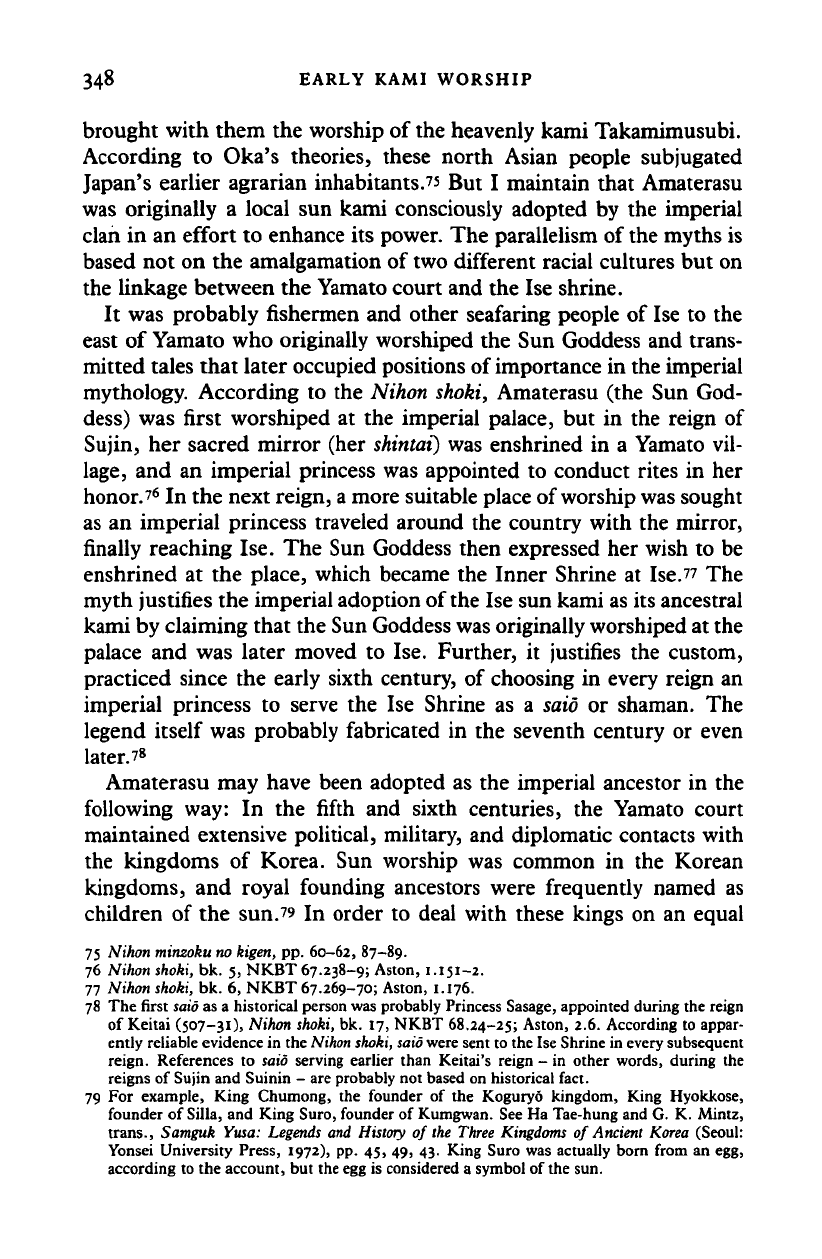
348 EARLY KAMI WORSHIP
brought with them the worship of the heavenly kami Takamimusubi.
According to Oka's theories, these north Asian people subjugated
Japan's earlier agrarian inhabitants.
75
But I maintain that Amaterasu
was originally a local sun kami consciously adopted by the imperial
clan in an effort to enhance its power. The parallelism of the myths is
based not on the amalgamation of two different racial cultures but on
the linkage between the Yamato court and the Ise shrine.
It was probably fishermen and other seafaring people of Ise to the
east of Yamato who originally worshiped the Sun Goddess and trans-
mitted tales that later occupied positions of importance in the imperial
mythology. According to the Nihon
shoki,
Amaterasu (the Sun God-
dess) was first worshiped at the imperial palace, but in the reign of
Sujin, her sacred mirror (her
shintaf)
was enshrined in a Yamato vil-
lage,
and an imperial princess was appointed to conduct rites in her
honor.
76
In the next reign, a more suitable place of worship was sought
as an imperial princess traveled around the country with the mirror,
finally reaching Ise. The Sun Goddess then expressed her wish to be
enshrined at the place, which became the Inner Shrine at Ise.
77
The
myth justifies the imperial adoption of
the
Ise sun kami as its ancestral
kami by claiming that the Sun Goddess was originally worshiped at the
palace and was later moved to Ise. Further, it justifies the custom,
practiced since the early sixth century, of choosing in every reign an
imperial princess to serve the Ise Shrine as a said or shaman. The
legend itself was probably fabricated in the seventh century or even
later.
78
Amaterasu may have been adopted as the imperial ancestor in the
following way: In the fifth and sixth centuries, the Yamato court
maintained extensive political, military, and diplomatic contacts with
the kingdoms of Korea. Sun worship was common in the Korean
kingdoms, and royal founding ancestors were frequently named as
children of the sun.
79
In order to deal with these kings on an equal
75 Nihon minzoku no kigen, pp. 60-62, 87-89.
76 Nihon shoki, bk. 5, NKBT 67.238-9; Aston, 1.151-2.
77 Nihon shoki, bk. 6, NKBT 67.269-70; Aston, 1.176.
78 The first said as a historical person was probably Princess Sasage, appointed during the reign
of Keitai (507-31), Nihon shoki, bk. 17, NKBT 68.24-25; Aston, 2.6. According to appar-
ently reliable evidence in the
Nihon
shoki, said were sent to the Ise Shrine in every subsequent
reign. References to said serving earlier than Keitai's reign - in other words, during the
reigns of Sujin and Suinin - are probably not based on historical fact.
79 For example, King Chumong, the founder of the Koguryo kingdom, King Hyokkose,
founder of Silla, and King Suro, founder of Kumgwan. See Ha Tae-hung and G. K. Mintz,
trans.,
Samguk Yusa: Legends and History of the Three Kingdoms of Ancient Korea (Seoul:
Yonsei University Press, 1972), pp. 45, 49, 43. King Suro was actually born from an egg,
according to the account, but the egg is considered a symbol of the sun.
Cambridge Histories Online © Cambridge University Press, 2008
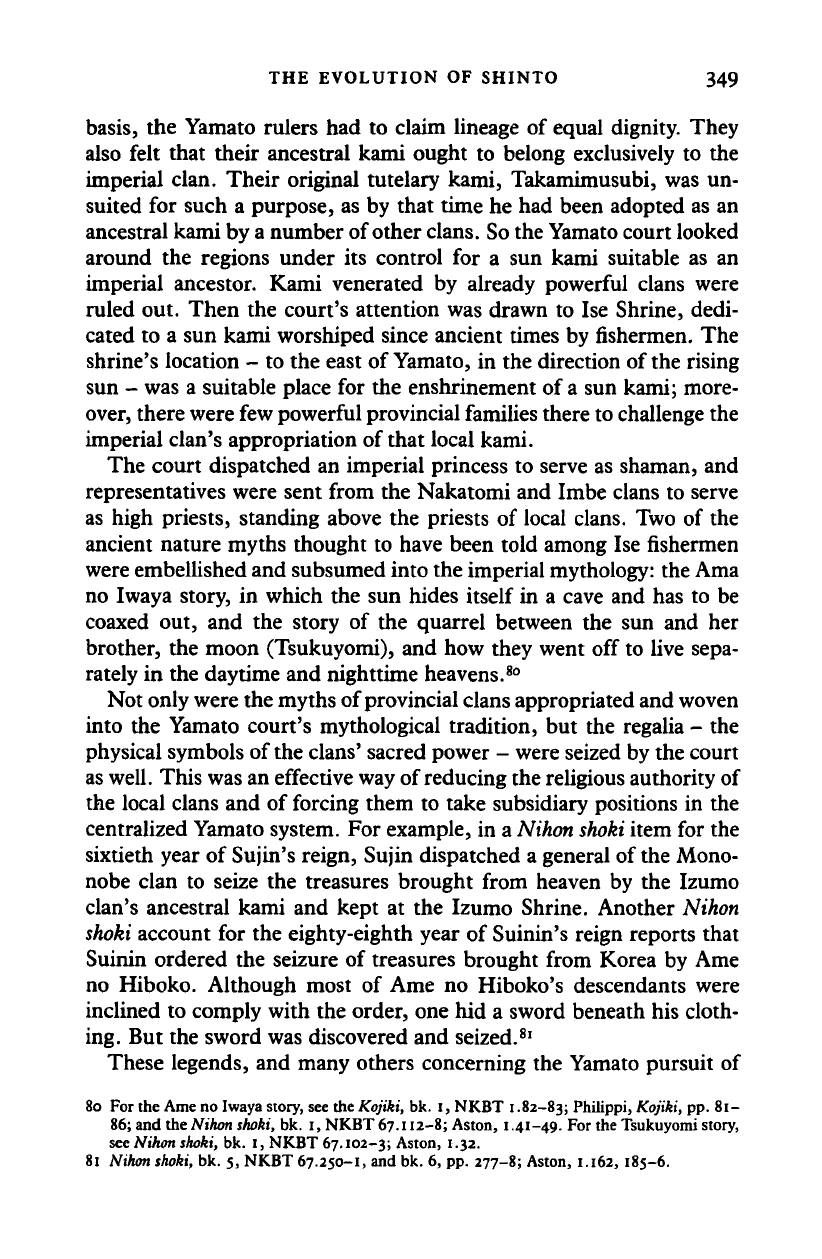
THE EVOLUTION OF SHINTO 349
basis,
the Yamato rulers had to claim lineage of equal dignity. They
also felt that their ancestral kami ought to belong exclusively to the
imperial clan. Their original tutelary kami, Takamimusubi, was un-
suited for such a purpose, as by that time he had been adopted as an
ancestral kami by a number of other
clans.
So the Yamato court looked
around the regions under its control for a sun kami suitable as an
imperial ancestor. Kami venerated by already powerful clans were
ruled out. Then the court's attention was drawn to Ise Shrine, dedi-
cated to a sun kami worshiped since ancient times by fishermen. The
shrine's location - to the east of
Yamato,
in the direction of the rising
sun - was a suitable place for the enshrinement of
a
sun kami; more-
over, there were few powerful provincial families there to challenge the
imperial clan's appropriation of that local kami.
The court dispatched an imperial princess to serve as shaman, and
representatives were sent from the Nakatomi and Imbe clans to serve
as high priests, standing above the priests of local clans. Two of the
ancient nature myths thought to have been told among Ise fishermen
were embellished and subsumed into the imperial mythology: the Ama
no Iwaya story, in which the sun hides itself in a cave and has to be
coaxed out, and the story of the quarrel between the sun and her
brother, the moon (Tsukuyomi), and how they went off to live sepa-
rately in the daytime and nighttime heavens.
80
Not only were the myths of provincial clans appropriated and woven
into the Yamato court's mythological tradition, but the regalia - the
physical symbols of the clans' sacred power - were seized by the court
as
well.
This was an effective way of reducing the religious authority of
the local clans and of forcing them to take subsidiary positions in the
centralized Yamato system. For example, in a
Nihon shoki
item for the
sixtieth year of Sujin's reign, Sujin dispatched a general of the Mono-
nobe clan to seize the treasures brought from heaven by the Izumo
clan's ancestral kami and kept at the Izumo Shrine. Another Nihon
shoki
account for the eighty-eighth year of Suinin's reign reports that
Suinin ordered the seizure of treasures brought from Korea by Ame
no Hiboko. Although most of Ame no Hiboko's descendants were
inclined to comply with the order, one hid a sword beneath his cloth-
ing. But the sword was discovered and seized.
81
These legends, and many others concerning the Yamato pursuit of
80 For the Ame no
Iwaya
story,
see the
Kojiki,
bk. I,
NKBT
1.82-83;
Philippi,
Kojiki,
pp. 81-
86; and the
Nihon
shoki,
bk. 1,
NKBT
67.112-8;
Aston,
1.41-49.
For the
Tsukuyomi
story,
see
Nihon
shoki,
bk. I,
NKBT
67.102-3;
Aston,
1.32.
81
Nihon
shoki,
bk. 5,
NKBT
67.250-1, and bk. 6, pp.
277-8;
Aston,
1.162,
185-6.
Cambridge Histories Online © Cambridge University Press, 2008
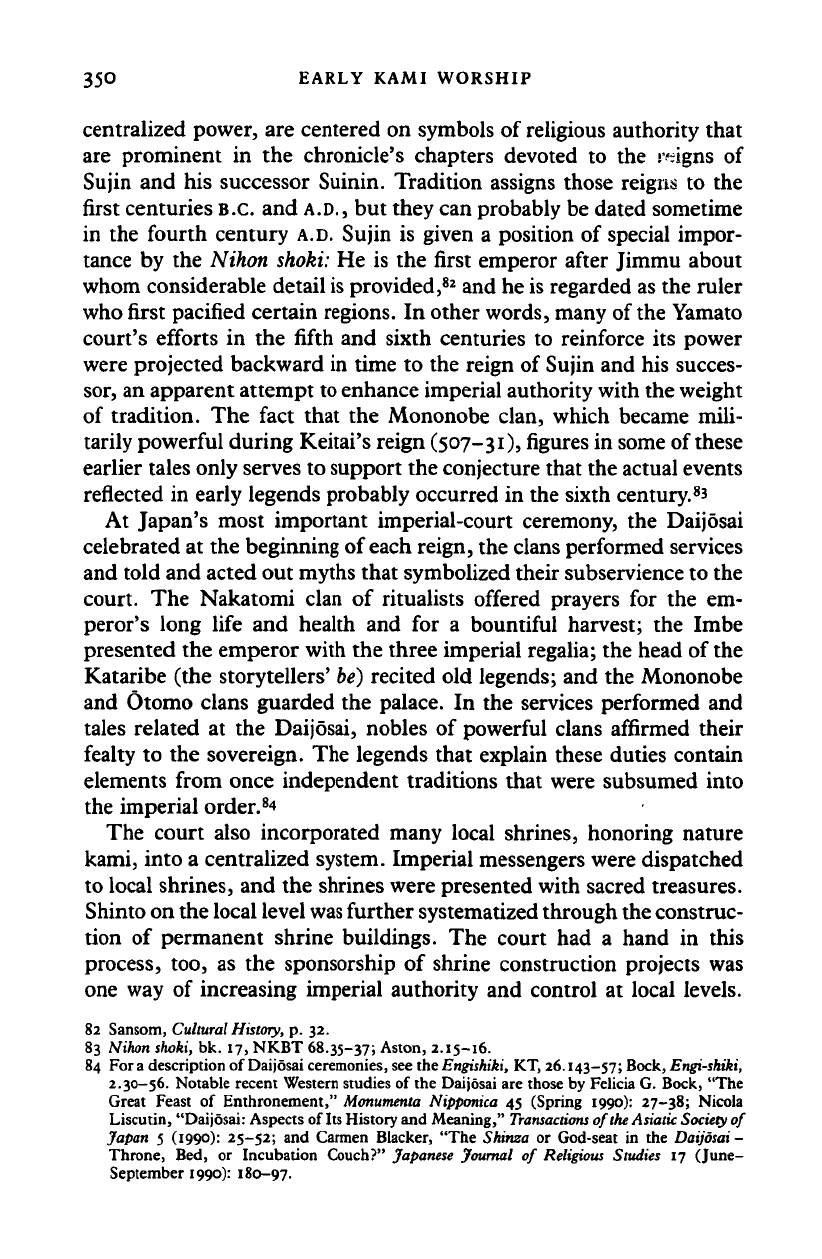
350 EARLY KAMI WORSHIP
centralized power, are centered on symbols of religious authority that
are prominent in the chronicle's chapters devoted to the reigns of
Sujin and his successor Suinin. Tradition assigns those reigns to the
first centuries
B.C.
and
A.D.,
but they can probably be dated sometime
in the fourth century
A.D.
Sujin is given a position of special impor-
tance by the Nihon
shoki:
He is the first emperor after Jimmu about
whom considerable detail
is
provided,
82
and he is regarded as the ruler
who first pacified certain regions. In other words, many of the Yamato
court's efforts in the fifth and sixth centuries to reinforce its power
were projected backward in time to the reign of Sujin and his succes-
sor, an apparent attempt
to
enhance imperial authority with the weight
of tradition. The fact that the Mononobe clan, which became mili-
tarily powerful during Keitai's reign (507-31),
figures
in some of these
earlier tales only serves to support the conjecture that the actual events
reflected in early legends probably occurred in the sixth century.
8
*
At Japan's most important imperial-court ceremony, the Daijosai
celebrated at the beginning of each reign, the clans performed services
and told and acted out myths that symbolized their subservience to the
court. The Nakatomi clan of ritualists offered prayers for the em-
peror's long life and health and for a bountiful harvest; the Imbe
presented the emperor with the three imperial regalia; the head of the
Kataribe (the storytellers'
be)
recited old legends; and the Mononobe
and Otomo clans guarded the palace. In the services performed and
tales related at the Daijosai, nobles of powerful clans affirmed their
fealty to the sovereign. The legends that explain these duties contain
elements from once independent traditions that were subsumed into
the imperial order.
8
t
The court also incorporated many local shrines, honoring nature
kami, into a centralized system. Imperial messengers were dispatched
to local shrines, and the shrines were presented with sacred treasures.
Shinto on the local level
was
further systematized through the construc-
tion of permanent shrine buildings. The court had a hand in this
process, too, as the sponsorship of shrine construction projects was
one way of increasing imperial authority and control at local levels.
82 Sansom, Cultural History, p. 32.
83 Nihon shoki, bk. 17, NKBT 68.35-37; Aston, 2.15-16.
84 For
a
description of Daijosai ceremonies, see the
Engishiki,
KT, 26.143-57; Bock, Engi-shiki,
2.30-56. Notable recent Western studies of the Daijosai are those by Felicia G. Bock, "The
Great Feast of Enthronement," Monumenta Nipponica 45 (Spring 1990): 27-38; Nicola
Liscutin, "Daijosai: Aspects of
Its
History and Meaning,"
Transactions
of
the
Asiatic Society
of
Japan 5 (1990): 25-52; and Carmen Blacker, "The Shinza or God-seat in the Daijosai-
Throne, Bed, or Incubation Couch?" Japanese Journal of Religious Studies 17 (June-
September 1990): 180-97.
Cambridge Histories Online © Cambridge University Press, 2008
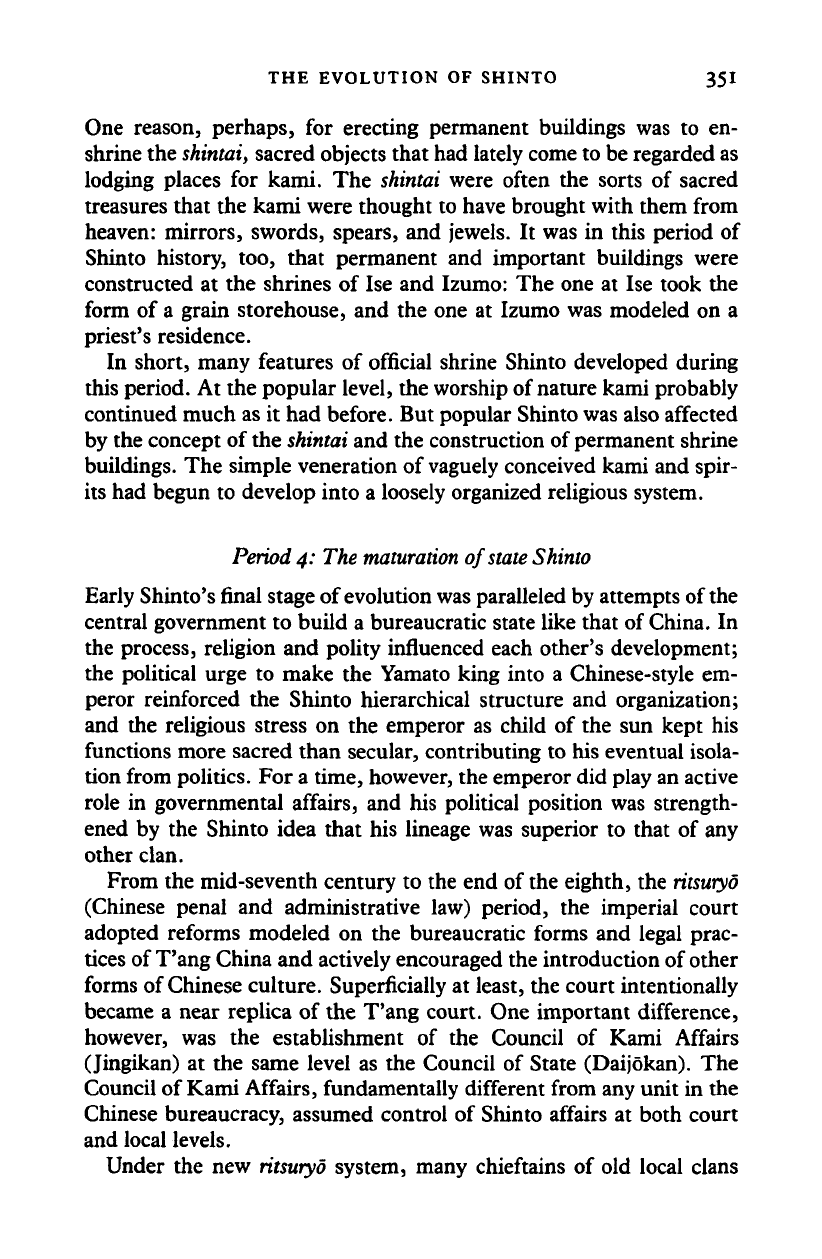
THE EVOLUTION OF SHINTO 351
One reason, perhaps, for erecting permanent buildings was to en-
shrine the
shintai,
sacred objects that had lately come to be regarded as
lodging places for kami. The shintai were often the sorts of sacred
treasures that the kami were thought to have brought with them from
heaven: mirrors, swords, spears, and jewels. It was in this period of
Shinto history, too, that permanent and important buildings were
constructed at the shrines of Ise and Izumo: The one at Ise took the
form of a grain storehouse, and the one at Izumo was modeled on a
priest's residence.
In short, many features of official shrine Shinto developed during
this period. At the popular level, the worship of nature kami probably
continued much as it had before. But popular Shinto was also affected
by the concept of the
shintai
and the construction of permanent shrine
buildings. The simple veneration of vaguely conceived kami and spir-
its had begun to develop into a loosely organized religious system.
Period 4: The maturation of state Shinto
Early Shinto's final stage of evolution was paralleled by attempts of the
central government to build a bureaucratic state like that of China. In
the process, religion and polity influenced each other's development;
the political urge to make the Yamato king into a Chinese-style em-
peror reinforced the Shinto hierarchical structure and organization;
and the religious stress on the emperor as child of the sun kept his
functions more sacred than secular, contributing to his eventual isola-
tion from politics. For a time, however, the emperor did play an active
role in governmental affairs, and his political position was strength-
ened by the Shinto idea that his lineage was superior to that of any
other clan.
From the mid-seventh century to the end of the eighth, the
ritsuryo
(Chinese penal and administrative law) period, the imperial court
adopted reforms modeled on the bureaucratic forms and legal prac-
tices of T'ang China and actively encouraged the introduction of other
forms of Chinese culture. Superficially at least, the court intentionally
became a near replica of the T'ang court. One important difference,
however, was the establishment of the Council of Kami Affairs
(Jingikan) at the same level as the Council of State (Daijokan). The
Council of Kami Affairs, fundamentally different from any unit in the
Chinese bureaucracy, assumed control of Shinto affairs at both court
and local levels.
Under the new
ritsuryo
system, many chieftains of old local clans
Cambridge Histories Online © Cambridge University Press, 2008
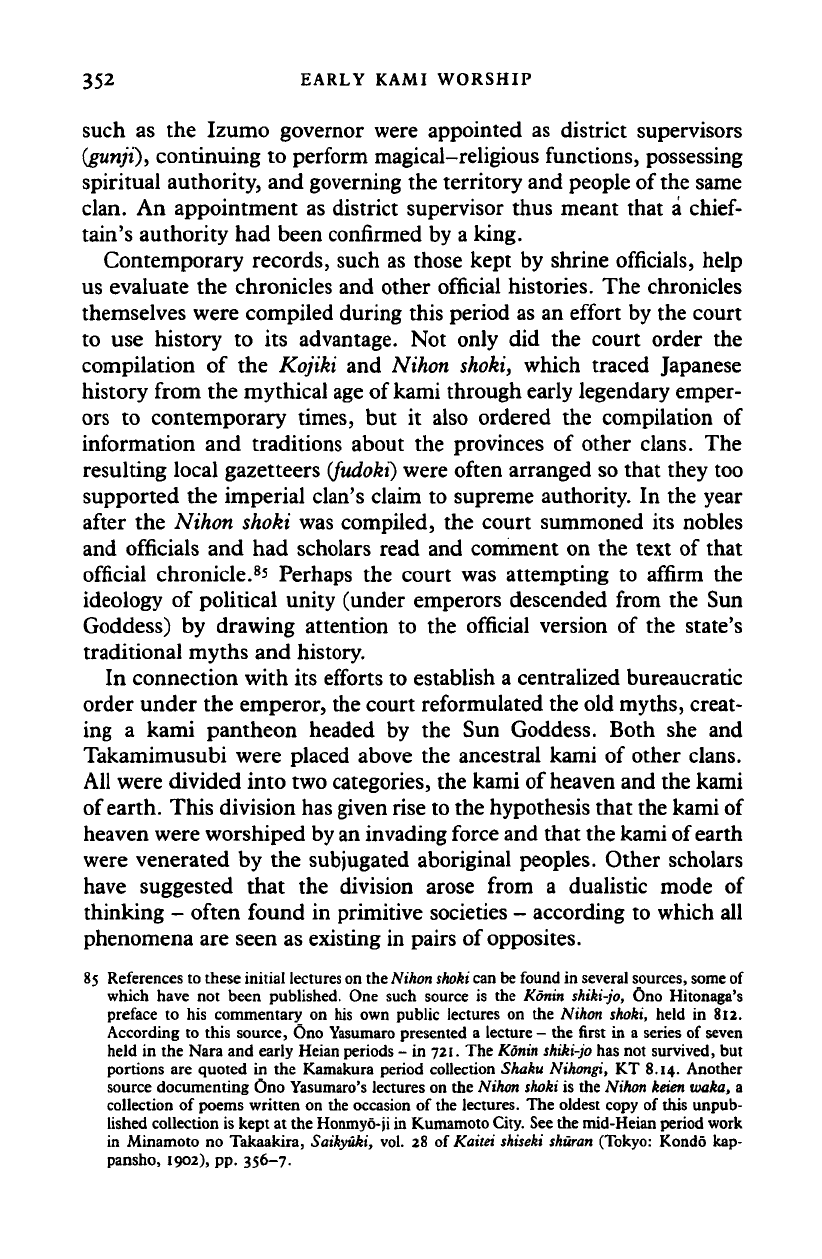
352 EARLY KAMI WORSHIP
such as the Izumo governor were appointed as district supervisors
igunji),
continuing to perform magical-religious functions, possessing
spiritual authority, and governing the territory and people of
the
same
clan. An appointment as district supervisor thus meant that a
chief-
tain's authority had been confirmed by a king.
Contemporary records, such as those kept by shrine officials, help
us evaluate the chronicles and other official histories. The chronicles
themselves were compiled during this period as an effort by the court
to use history to its advantage. Not only did the court order the
compilation of the Kojiki and Nihon shoki, which traced Japanese
history from the mythical age of kami through early legendary emper-
ors to contemporary times, but it also ordered the compilation of
information and traditions about the provinces of other clans. The
resulting local gazetteers
(fudoki)
were often arranged so that they too
supported the imperial clan's claim to supreme authority. In the year
after the Nihon shoki was compiled, the court summoned its nobles
and officials and had scholars read and comment on the text of that
official chronicle.
8
' Perhaps the court was attempting to affirm the
ideology of political unity (under emperors descended from the Sun
Goddess) by drawing attention to the official version of the state's
traditional myths and history.
In connection with its efforts to establish a centralized bureaucratic
order under the emperor, the court reformulated the old myths, creat-
ing a kami pantheon headed by the Sun Goddess. Both she and
Takamimusubi were placed above the ancestral kami of other clans.
All were divided into two categories, the kami of heaven and the kami
of earth. This division has given rise to the hypothesis that the kami of
heaven were worshiped by an invading force and that the kami of earth
were venerated by the subjugated aboriginal peoples. Other scholars
have suggested that the division arose from a dualistic mode of
thinking - often found in primitive societies - according to which all
phenomena are seen as existing in pairs of opposites.
85 References to these initial lectures on the
Nihon shoki
can be found in several sources, some
of
which have not been published. One such source is the Konin
shiki-jo,
Ono Hitonaga's
preface to his commentary on his own public lectures on the Nihon shoki, held in 812.
According to this source, Ono Yasumaro presented a lecture - the first in a series of seven
held in the Nara and early Heian periods - in
721.
The
Konin shiki-jo
has not survived, but
portions are quoted in the Kamakura period collection Shaku
Nihongi,
KT 8.14. Another
source documenting Ono Yasumaro's lectures on the
Nihon shoki
is the
Nihon keien
tvaka,
a
collection of poems written on the occasion of the lectures. The oldest copy of this unpub-
lished collection is kept at the Honmyo-ji in Kumamoto
City.
See the mid-Heian period work
in Minamoto no Takaakira, Saikyuki, vol. 28 of
Kaitei shiseki shuran
(Tokyo: Kondo kap-
pansho, 1902), pp. 356-7.
Cambridge Histories Online © Cambridge University Press, 2008
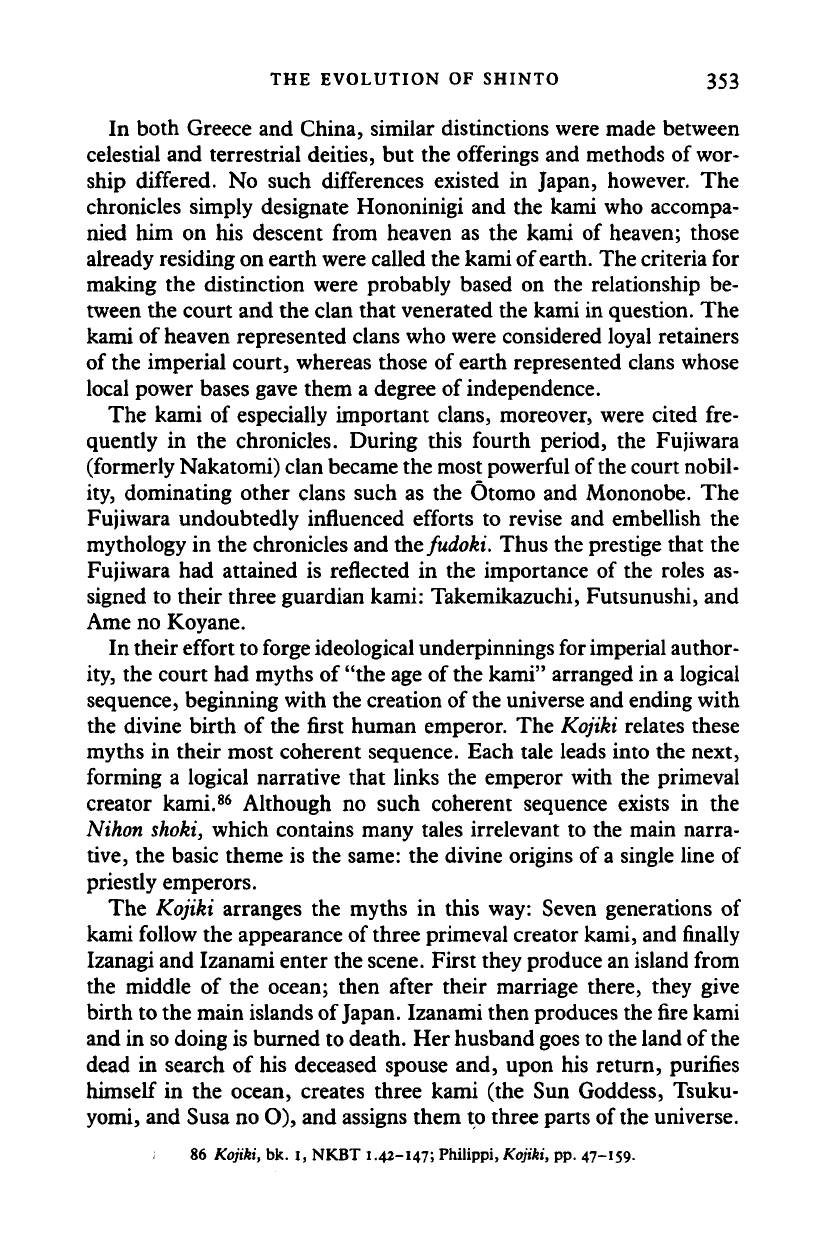
THE EVOLUTION OF SHINTO 353
In both Greece and China, similar distinctions were made between
celestial and terrestrial deities, but the offerings and methods of wor-
ship differed. No such differences existed in Japan, however. The
chronicles simply designate Hononinigi and the kami who accompa-
nied him on his descent from heaven as the kami of heaven; those
already residing on earth were called the kami of earth. The criteria for
making the distinction were probably based on the relationship be-
tween the court and the clan that venerated the kami in question. The
kami of heaven represented clans who were considered loyal retainers
of the imperial court, whereas those of earth represented clans whose
local power bases gave them a degree of independence.
The kami of especially important clans, moreover, were cited fre-
quently in the chronicles. During this fourth period, the Fujiwara
(formerly Nakatomi) clan became the most powerful of the court nobil-
ity, dominating other clans such as the Otomo and Mononobe. The
Fujiwara undoubtedly influenced efforts to revise and embellish the
mythology in the chronicles and thefudoki. Thus the prestige that the
Fujiwara had attained is reflected in the importance of the roles as-
signed to their three guardian kami: Takemikazuchi, Futsunushi, and
Ame no Koyane.
In their effort to forge ideological underpinnings for imperial author-
ity, the court had myths of "the age of the kami" arranged in a logical
sequence, beginning with the creation of the universe and ending with
the divine birth of the first human emperor. The Kojiki relates these
myths in their most coherent sequence. Each tale leads into the next,
forming a logical narrative that links the emperor with the primeval
creator kami.
86
Although no such coherent sequence exists in the
Nihon shoki, which contains many tales irrelevant to the main narra-
tive,
the basic theme is the same: the divine origins of
a
single line of
priestly emperors.
The Kojiki arranges the myths in this way: Seven generations of
kami follow the appearance of three primeval creator kami, and finally
Izanagi and Izanami enter the
scene.
First they produce an island from
the middle of the ocean; then after their marriage there, they give
birth to the main islands of Japan. Izanami then produces the fire kami
and in so doing is burned to death. Her husband goes to the land of the
dead in search of his deceased spouse and, upon his return, purifies
himself in the ocean, creates three kami (the Sun Goddess, Tsuku-
yomi, and Susa no O), and assigns them to three parts of
the
universe.
86 Kojiki, bk. I, NKBT 1.42-147; Philippi, Kojiki, pp. 47-159.
Cambridge Histories Online © Cambridge University Press, 2008
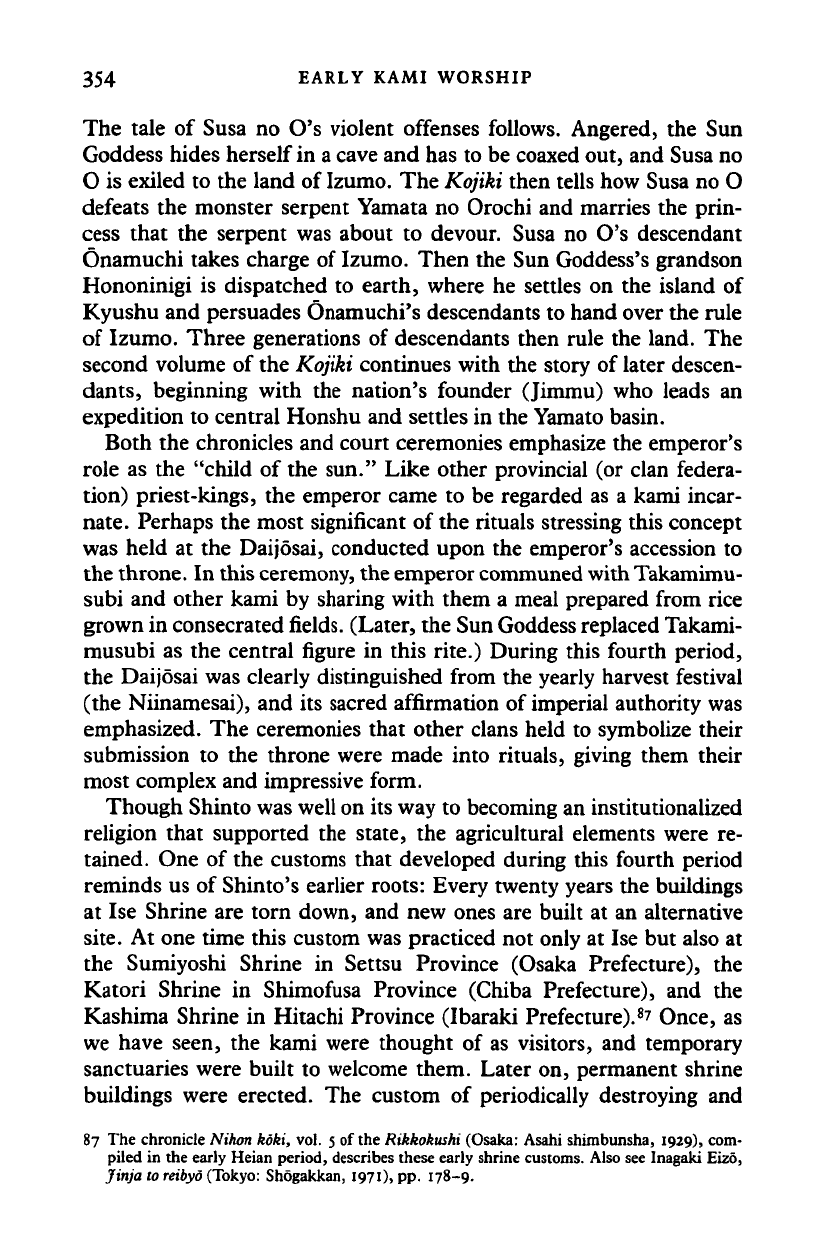
354 EARLY KAMI WORSHIP
The tale of Susa no O's violent offenses follows. Angered, the Sun
Goddess hides herself in
a
cave and has to be coaxed out, and Susa no
O is exiled to the land of
Izumo.
The Kojiki then tells how Susa no O
defeats the monster serpent Yamata no Orochi and marries the prin-
cess that the serpent was about to devour. Susa no O's descendant
Onamuchi takes charge of Izumo. Then the Sun Goddess's grandson
Hononinigi is dispatched to earth, where he settles on the island of
Kyushu and persuades Onamuchi's descendants to hand over the rule
of Izumo. Three generations of descendants then rule the land. The
second volume of the Kojiki continues with the story of later descen-
dants,
beginning with the nation's founder (Jimmu) who leads an
expedition to central Honshu and settles in the Yamato basin.
Both the chronicles and court ceremonies emphasize the emperor's
role as the "child of the sun." Like other provincial (or clan federa-
tion) priest-kings, the emperor came to be regarded as a kami incar-
nate.
Perhaps the most significant of the rituals stressing this concept
was held at the Daijosai, conducted upon the emperor's accession to
the throne. In this ceremony, the emperor communed with Takamimu-
subi and other kami by sharing with them a meal prepared from rice
grown in consecrated fields. (Later, the Sun Goddess replaced Takami-
musubi as the central figure in this rite.) During this fourth period,
the Daijosai was clearly distinguished from the yearly harvest festival
(the Niinamesai), and its sacred affirmation of imperial authority was
emphasized. The ceremonies that other clans held to symbolize their
submission to the throne were made into rituals, giving them their
most complex and impressive form.
Though Shinto was well on its way to becoming an institutionalized
religion that supported the state, the agricultural elements were re-
tained. One of the customs that developed during this fourth period
reminds us of Shinto's earlier roots: Every twenty years the buildings
at Ise Shrine are torn down, and new ones are built at an alternative
site.
At one time this custom was practiced not only at Ise but also at
the Sumiyoshi Shrine in Settsu Province (Osaka Prefecture), the
Katori Shrine in Shimofusa Province (Chiba Prefecture), and the
Kashima Shrine in Hitachi Province (Ibaraki Prefecture).
87
Once, as
we have seen, the kami were thought of as visitors, and temporary
sanctuaries were built to welcome them. Later on, permanent shrine
buildings were erected. The custom of periodically destroying and
87 The chronicle Nihon koki, vol.
5
of the
Rikkokushi
(Osaka: Asahi shimbunsha, 1929), com-
piled in the early Heian period, describes these early shrine customs. Also see Inagaki Eizo,
Jinja
to reibyo
(Tokyo: Shogakkan, 1971), pp. 178-9.
Cambridge Histories Online © Cambridge University Press, 2008
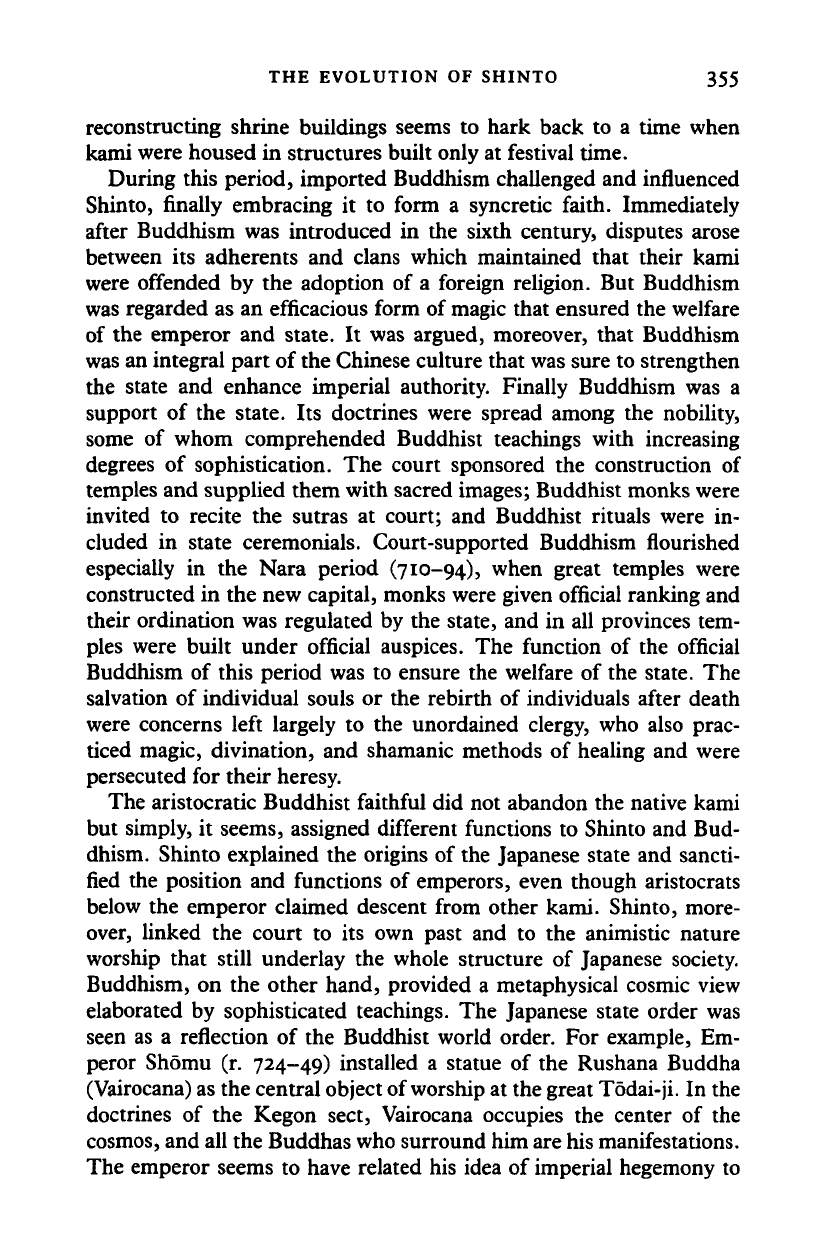
THE EVOLUTION OF SHINTO 355
reconstructing shrine buildings seems to hark back to a time when
kami were housed in structures built only at festival time.
During this period, imported Buddhism challenged and influenced
Shinto, finally embracing it to form a syncretic faith. Immediately
after Buddhism was introduced in the sixth century, disputes arose
between its adherents and clans which maintained that their kami
were offended by the adoption of a foreign religion. But Buddhism
was regarded as an efficacious form of magic that ensured the welfare
of the emperor and state. It was argued, moreover, that Buddhism
was an integral part of the Chinese culture that was sure to strengthen
the state and enhance imperial authority. Finally Buddhism was a
support of the state. Its doctrines were spread among the nobility,
some of whom comprehended Buddhist teachings with increasing
degrees of sophistication. The court sponsored the construction of
temples and supplied them with sacred images; Buddhist monks were
invited to recite the sutras at court; and Buddhist rituals were in-
cluded in state ceremonials. Court-supported Buddhism nourished
especially in the Nara period (710-94), when great temples were
constructed in the new capital, monks were given official ranking and
their ordination was regulated by the state, and in all provinces tem-
ples were built under official auspices. The function of the official
Buddhism of this period was to ensure the welfare of the state. The
salvation of individual souls or the rebirth of individuals after death
were concerns left largely to the unordained clergy, who also prac-
ticed magic, divination, and shamanic methods of healing and were
persecuted for their heresy.
The aristocratic Buddhist faithful did not abandon the native kami
but simply, it seems, assigned different functions to Shinto and Bud-
dhism. Shinto explained the origins of the Japanese state and sancti-
fied the position and functions of emperors, even though aristocrats
below the emperor claimed descent from other kami. Shinto, more-
over, linked the court to its own past and to the animistic nature
worship that still underlay the whole structure of Japanese society.
Buddhism, on the other hand, provided a metaphysical cosmic view
elaborated by sophisticated teachings. The Japanese state order was
seen as a reflection of the Buddhist world order. For example, Em-
peror Shomu (r. 724-49) installed a statue of the Rushana Buddha
(Vairocana) as the central object of worship at the great T6dai-ji. In the
doctrines of the Kegon sect, Vairocana occupies the center of the
cosmos, and all the Buddhas who surround him are his manifestations.
The emperor seems to have related his idea of imperial hegemony to
Cambridge Histories Online © Cambridge University Press, 2008
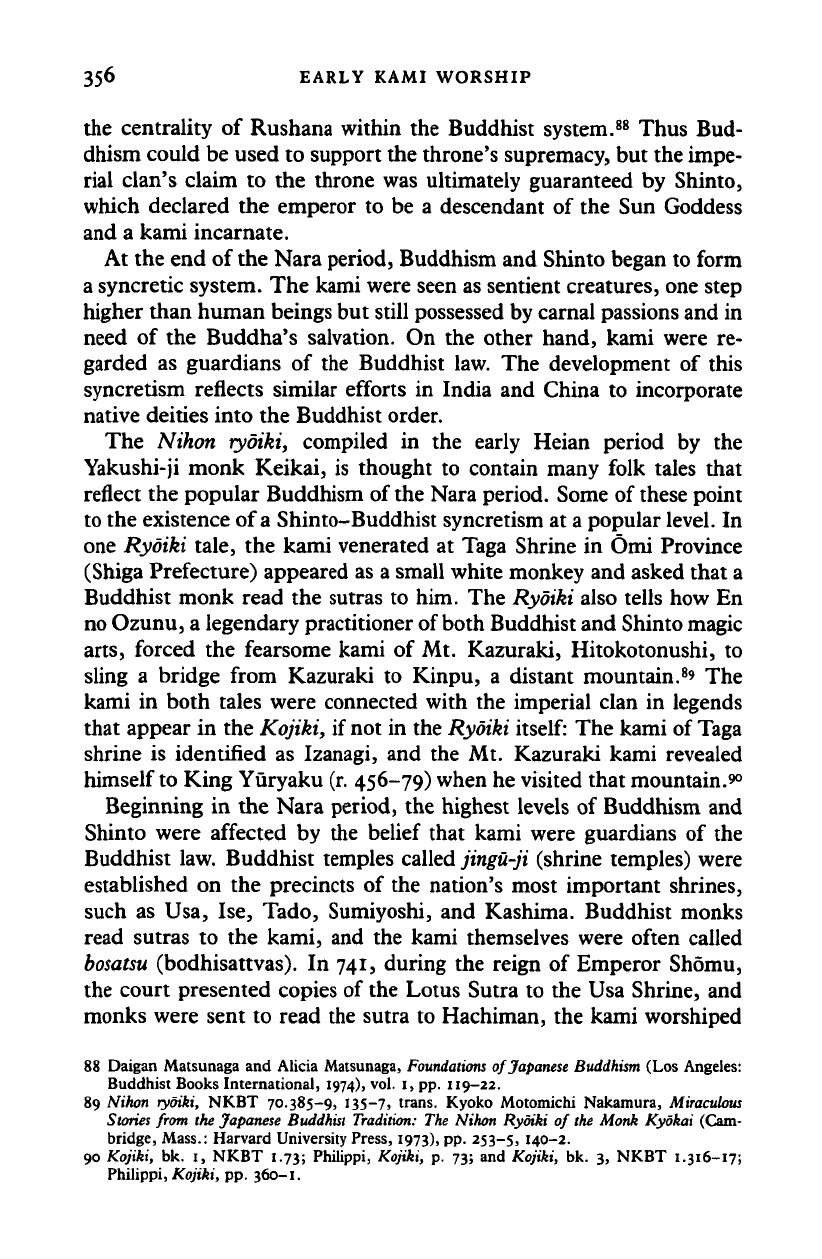
356 EARLY KAMI WORSHIP
the centrality of Rushana within the Buddhist system.
88
Thus Bud-
dhism could be used to support the throne's supremacy, but the impe-
rial clan's claim to the throne was ultimately guaranteed by Shinto,
which declared the emperor to be a descendant of the Sun Goddess
and a kami incarnate.
At the end of the Nara period, Buddhism and Shinto began to form
a syncretic system. The kami were seen as sentient creatures, one step
higher than human beings but still possessed by carnal passions and in
need of the Buddha's salvation. On the other hand, kami were re-
garded as guardians of the Buddhist law. The development of this
syncretism reflects similar efforts in India and China to incorporate
native deities into the Buddhist order.
The Nihon ryoiki, compiled in the early Heian period by the
Yakushi-ji monk Keikai, is thought to contain many folk tales that
reflect the popular Buddhism of the Nara period. Some of these point
to the existence of a Shinto-Buddhist syncretism at a popular
level.
In
one Ryoiki tale, the kami venerated at Taga Shrine in Omi Province
(Shiga Prefecture) appeared as a small white monkey and asked that a
Buddhist monk read the sutras to him. The Ryoiki also tells how En
no Ozunu, a legendary practitioner of both Buddhist and Shinto magic
arts,
forced the fearsome kami of Mt. Kazuraki, Hitokotonushi, to
sling a bridge from Kazuraki to Kinpu, a distant mountain.
8
» The
kami in both tales were connected with the imperial clan in legends
that appear in the Kojiki, if not in the Ryoiki
itself:
The kami of Taga
shrine is identified as Izanagi, and the Mt. Kazuraki kami revealed
himself to King Yuryaku (r. 456-79) when he visited that mountain.
90
Beginning in the Nara period, the highest levels of Buddhism and
Shinto were affected by the belief that kami were guardians of the
Buddhist law. Buddhist temples called
jingu-ji
(shrine temples) were
established on the precincts of the nation's most important shrines,
such as Usa, Ise, Tado, Sumiyoshi, and Kashima. Buddhist monks
read sutras to the kami, and the kami themselves were often called
bosatsu
(bodhisattvas). In 741, during the reign of Emperor Shdmu,
the court presented copies of the Lotus Sutra to the Usa Shrine, and
monks were sent to read the sutra to Hachiman, the kami worshiped
88 Daigan Matsunaga and Alicia Matsunaga,
Foundations
of Japanese Buddhism (Los Angeles:
Buddhist Books International, 1974), vol. I, pp. 119-22.
89 Nihon ryoiki, NKBT 70.385-9, 135-7, trans. Kyoko Motomichi Nakamura, Miraculous
Stories from the Japanese Buddhist Tradition: The Nihon Ryoiki of the Monk Kyokai (Cam-
bridge, Mass.: Harvard University Press, 1973), pp. 253-5, 140-2.
90 Kojiki, bk. i, NKBT 1.73; Philippi, Kojiki, p. 73; and Kojiki, bk. 3, NKBT 1.316-17;
Philippi, Kojiki, pp.
360-1.
Cambridge Histories Online © Cambridge University Press, 2008
